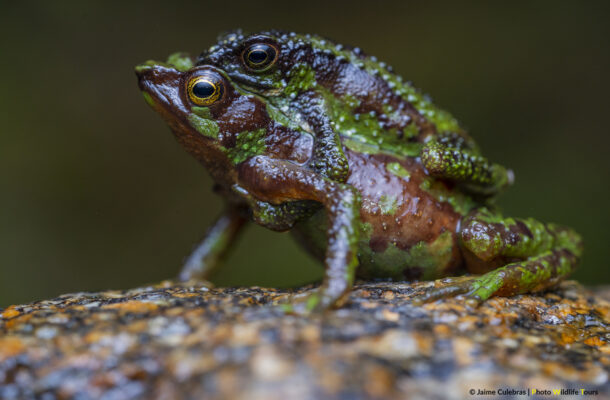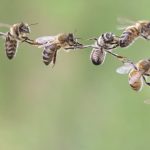Amphibian apocalypse

Two out of every five amphibian species are threatened with extinction according to a global study published in the scientific journal Nature.
The study, Ongoing declines for the world’s amphibians in the face of emerging threats, shows the continuing increase in extinction risk for the world’s most threatened vertebrates.
While habitat loss is still the most common threat to amphibians, and disease remains a substantial issue, the study found climate change has emerged as an increasing threat driving many amphibians towards extinction.
James Cook University Associate Professor Conrad Hoskin is one of more than 1,000 experts across the globe who contributed their data and expertise to this second global amphibian assessment, coordinated by the Amphibian Specialist Group of the International Union for Conservation of Nature’s (IUCN) Species Survival Commission.
“The study shows that the world’s amphibian diversity is under threat,” Associate Professor Hoskin said. “We can see this clearly in the rainforest mountains of north Queensland, where species are now extinct, or nearly gone, due to disease impacts and many others are now Critically Endangered by climate change. We must act now if these species are to be saved.”
The assessment evaluated the extinction risk of more than 8,000 amphibian species from all over the world, including 2,286 species evaluated for the first time. These data will be published on the IUCN Red List of Threatened Species™.
The Nature paper provides an update to a 2004 landmark study that was based on the first global amphibian assessment for the IUCN Red List, which revealed the unfolding amphibian crisis for the first time and established a baseline for monitoring trends and measuring conservation success or failure.
According to this new study, nearly 41 per cent of all amphibian species that have been assessed are currently globally threatened (considered Critically Endangered, Endangered or Vulnerable). This is compared to 27 per cent of mammals, 21 per cent of reptiles and 13 per cent of birds. This makes amphibians incomparably the most threatened group of vertebrate animals.
To exemplify the dire situation, in the last 20 years, more amphibian species have been documented to have gone extinct or are deemed highly likely to be extinct. Globally there are 185 species that are now possibly extinct, with currently no known surviving populations in the wild.
“Three of these species have disappeared from the rainforest mountains of north-east Queensland,” Dr Hoskin said. “The Sharp-snouted Day Frog, the Northern Tinker Frog, and the Mountain Mist Frog are likely extinct, and this study tells us that many more species could follow.”
“By their nature, amphibians are sensitive to environmental threats and changes. When frogs and other amphibians are in danger, it’s an important warning for us all.”
Over the past few decades, Australian amphibians have been particularly heavily impacted by disease, which was the main cause of all five extinctions. However, climate change is now emerging as the biggest threat to Australian frogs. The Endangered and Critically Endangered lists are now dominated by frog species at high risk from climate change impacts, especially in the mountains of eastern Australia, with one in five Australian amphibians considered threatened.
“Amphibians are very environmentally sensitive, and the rapid emergence of climate change as a major threat is a dire warning for all biodiversity. We must act now if future extinctions are to be avoided,” Janice Chanson, Global Co-Coordinator IUCN/SSC Amphibian Specialist Group Red List Authority, said.
The study found that in the last 20 years, more than 300 amphibian species have moved closer to extinction (i.e., they have moved to more highly threatened IUCN categories). Climate change was the primary threat for 39% of these species, and this number is expected to rise as more accurate data and projections on species’ responses to climate change become available. Beyond general warming, climate change is increasing the frequency, intensity and scale of heatwaves, droughts and bushfires, all of which are potentially devastating for amphibian populations.
The Australian federal government has committed to a zero-extinction target and to protecting 30% of land for conservation by 2030. Studies such as these provide the knowledge needed to meet these targets, but now what is urgently required are resources to act and save amphibian diversity in Australia and globally. Without a substantial increase in investment and commitment to conservation we will continue to lose these incredible and important species at an alarming rate.
Dr Jodi Rowley, Curator of Amphibian and Reptile Conservation Biology at the Australian Museum and UNSW Sydney, said the study is a wake-up call.
“It highlights the ongoing plight of amphibians, such a vital part of our biodiversity. However, the study also provides hope. If we act now, we have the power to turn things around for threatened amphibian species.”
Open Forum is a policy discussion website produced by Global Access Partners – Australia’s Institute for Active Policy. We welcome contributions and invite you to submit a blog to the editor and follow us on Twitter, Facebook, Linkedin and Mastadon.















